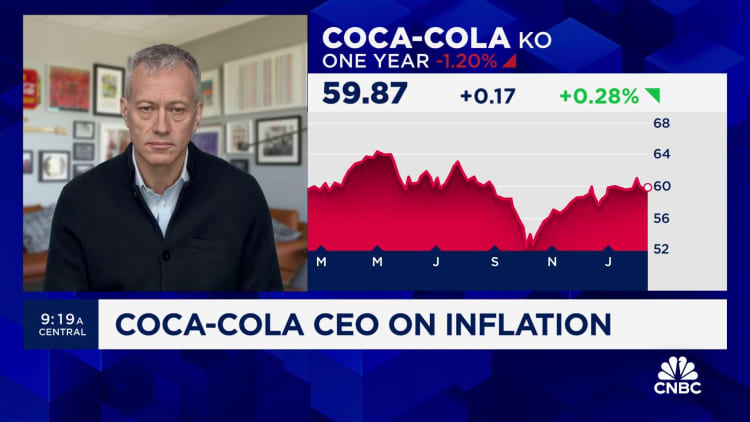A man with a paper bag of groceries looks surprised and upset at a receipt from a supermarket with high prices against the background of an escalator with customers in the shopping center.Â
Elena Perova | Istock | Getty Images
Just ahead of the holiday season, Walmart had encouraging news for inflation-weary shoppers: Prices on food and other staples were falling instead of rising. The retail giant said if the trend continued, it would soon contend with deflation in some of those key household categories, which would be a welcome sight for consumers emerging from the worst price increases in decades.
But the retail giant backpedaled this week, saying higher prices on many grocery items and household staples like paper goods have stuck.
“There is deflation in certain categories â the possibility overall still remains â but prices are more stable than where they were three months ago,” CFO John David Rainey told CNBC.
In recent weeks, corporate leaders have sung a similar tune â at a time when inflation is cooling but prices are still rising faster than the Federal Reserve would like. Home Depot said the prices of home improvement items have “settled” rather than fallen. Coca-Cola and the makers of other popular brands of snacks, sodas and household essentials said their prices are still ticking higher than a year ago. While they’re planning for more modest price hikes, shoppers should not expect price cuts, either.
“If one looks at inflation over time, we very rarely get into periods of sustained deflation. That’s just not a consumer effect,” Coke CEO James Quincey said Feb. 13 on CNBC’s “Squawk on the Street.”

The latest government data backs that up: while the rate of price increase is dipping year over year, the latest inflation metric came in hotter than expected. The consumer price index, a broad measure used to track what shoppers pay for goods and services across the economy, rose 3.1% in January from the prior year.
Food prices climbed 2.6%, fueled by a 5.1% jump in prices for food away from home, a category that includes restaurant meals and vending machine purchases.
While prices broadly are still climbing, shoppers have seen relief in some areas. For instance, prices of consumer electronics, used cars and some other categories of general merchandise have tumbled. Wages have also kept rising, softening the blow as some prices have stayed high.
Inflation vaulted to the top of the minds of shoppers, executives and investors over the last two years as soaring prices stretched household budgets and forced shoppers to reevaluate where and how much they spend. Price hikes helped companies offset higher input costs and maintain growth â even as consumers bought less while they were forced to fork up more money. The Federal Reserve took on the challenging task of reining in rising prices without tipping the economy into a recession, slowing inflation, but shoppers have only felt so much relief.
The cost of everyday items topped Americans’ economic worries in a Pew Research Center survey conducted Jan. 16 to Jan. 21. Seventy-two percent of respondents said that they were “very” concerned about the price of food and consumer goods.
While deflation could offer consumers relief, it can be a tricky dynamic to navigate, too. In many cases, companies might opt to protect profits rather than pass on lower input costs to consumers. Otherwise, they risk shrinking sales and a falling stock price.
Plus, executives may not want to cut prices or say deflation is happening, since investors could take it as a sign that a company’s brand or the economy as a whole has weakened.
“You rarely see prices go down on a uniform basis outside of recessions or deep recession,” said Gregory Daco, chief economist at EY.
However, consumers sometimes benefit from price “corrections,” he said. For example, airfares plunged during the pandemic and surged after it, but now have leveled out again.
The prices that are falling â and aren’t
So far, the unwinding of historic inflation has been uneven.
Products like chicken or eggs have been more likely to see prices slashed inside the grocery store. Tyson said chicken prices fell 3.9% in its fiscal first quarter. Egg producer Cal-Maine Foods reported that the average price per dozen eggs was cut in half in the quarter ended Dec. 2 compared with the year-ago period, when the price of eggs spiked. Unilever CFO Fernando Fernandez also called out price cuts for at-home ice cream, laundry and skin cleansing bars on the company’s Feb. 8 conference call.
“We’ve seen deflation first in the commodity-oriented categories,” said CFRA analyst Arun Sundaram. “I think it will take some time before packaged food pricing comes down.”
But not all commodities have tumbled in price. Cocoa, sugar and tomatoes have all shot up more recently, hurting companies like Kraft Heinz and Nestle. Chocolate maker Hershey said it raised prices slightly on some items earlier this month.
Though many input cost pressures for businesses have eased, expenses are climbing faster than before the unprecedented demand boom of 2021. Most companies are seeing costs up around 3%, still higher than pre-pandemic inflation of 1% to 2%, according to Edward Jones analyst Brittany Quatrochi.
Chocolate bars are displayed for sale at Hershey’s Chocolate World store in Hershey, Pennsylvania, on July 13, 2018.
Bloomberg | Bloomberg | Getty Images
Items with strong brands, such as soda or snacks, typically have greater pricing power and less competition from private label products because of their distinct flavor or fan following. That gives their makers the ability to keep raising prices to mitigate higher costs, even as their volume drops.
On the other hand, customers are more likely to swap to a cheaper product or a store brand for items that don’t have a unique flavor or taste, such as a container of peanuts. That’s one reason why Kraft Heinz sold its Planters nuts business to Hormel three years ago.
“The more ingredients in the product, the more pricing power you have typically,” Sundaram said.
Retailers, including Target and Kroger, have rolled out new private brands to better compete with national brands and undercut them on price. Earlier this month, Target debuted Dealworthy, a brand made up of products including dental floss, paper towels and shampoo. Most of the new brand’s goods sell for under $10.
By stealing away sales, retailers can pressure national brands to lower an item’s price, introduce a cheaper version or offer a discount.
Some industry watchers expect a meaningful wave of price cuts as food makers struggle with weaker demand and lagging sales growth.
A number of food suppliers reported shrinking volume in North America in their latest quarters, including Kraft Heinz, Pringles maker Kellanova and PepsiCo’s food divisions. Volume excludes pricing and currency changes, giving investors a more accurate view of demand.
Heinz ketchup is displayed on a shelf at a grocery store in Washington, DC, on February 15, 2023.
Stefani Reynolds | AFP | Getty Images
KeyBanc retail analyst Brad Thomas said those softer trends will force brands to cut their prices or give customers another reason to buy their product, such as offering a short-term promotion or innovative features.
“The ongoing ‘frenemy’ relationship between retailers and suppliers â where you push for lower prices â is part of the normal course of business,” he said. “What’s different about what’s happening now is how much volume the CPG [consumer packaged goods] brands are losing.”
He predicts that food-at-home prices will turn negative later this year. CFRA’s Sundaram echoed that prediction, while noting that costs need to keep falling, too.
Historically, food deflation happens about once a decade and lasts about eight months, according to Thomas. The last time was in 2016 and 2017, and Walmart was the biggest winner. Rival Target did not see the same benefit.
Even some of the biggest U.S. brands have signaled that consumers’ tolerance of higher prices has worn thin. Some companies have said they’re done hiking prices or pledged that the increases will be more modest this year.
A man climbs into the fridge for milk at a Walmart store in Rosemead, California on November 22, 2022.
Frederic J. Brown | AFP | Getty Images
For example, Kraft Heinz said on Feb. 14 that it expects its input costs will rise 3% this year; however, the Oscar Mayer owner is only planning to raise prices by 1%. The company is counting on productivity savings to make up the difference.
PepsiCo executives also said they expect to return to more “normalized” pricing in 2024. In the fourth quarter, Pepsi’s prices for its North American Frito-Lay business rose 5%, while those for its North American beverage unit climbed 9% compared with the year-ago period.
Still, Thomas acknowledged that brands with a strong following, such as Coca-Cola, will likely keep products pricier. Mid-tier brands are more vulnerable and will have to reduce their prices.
Who’s wary of deflation
Just as inflation has become a dirty word, deflation can be one, too, said Greg Melich, a retail analyst for Evercore ISI.
“High inflation is bad, but deflation is bad, too, because you have fixed costs that aren’t going down,” he said.
Wage costs have risen as new minimum wage laws take effect and the labor market remains tight. Many food companies are locked into supplier contracts signed when commodities cost more.
Deflation can also cause concern that a company’s overall revenue may fall.
According to a KeyBanc estimate, a 1% drop in food prices would add $1 billion per month more to consumer spending, and lower-income households would benefit the most. But shoppers can choose to hang onto those savings instead of spending the extra cash.
For instance, Home Depot saw lumber prices drop over the past year, but it still has seen weaker demand for larger home projects amid higher interest rates. Best Buy sells consumer electronics, another deflationary category, but has struggled to drive more sales after the buying boom during the pandemic and as product innovation lags.
Melich said if customers spend less on necessities like food, they may buy more discretionary items, “but you can’t assume there’s a one to one transfer.”
Wall Street reflected those concerns in November when Walmart said deflation could be coming soon. Shares of the retail giant slid about 8%, their worst day in over a year at the time. (Walmart’s shares have been hovering near an all-time high).
Home Depot CFO Richard McPhail acknowledged the loaded meaning of deflation in a recent CNBC interview.
“I’m very careful with the word ‘deflation’ because of what it represents in people’s minds,” he said.
McPhail described prices as “settling” rather than declining. He said the home improvement retailer had not seen “significant movement in prices” since early August.
Even as Walmart scaled back widespread deflation predictions, its CFO Rainey said the discounter ultimately believes lower prices would be a good thing.
Walmart has seen deflation in general merchandise categories, even though food prices are still rising by low-single digits year-over-year.
“To be very clear, we want lower prices for our customers,” Rainey said.
â CNBC’s Christopher Hayes contributed to this report.

